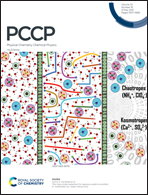Bond dissociation energies of low-valent lanthanide hydroxides: lower limits from ion–molecule reactions and comparisons with fluorides†
Abstract
Despite that bond dissociation energies (BDEs) are among the most fundamental and relevant chemical properties they remain poorly characterized for most elementary lanthanide hydroxides and halides. Lanthanide ions Ln+ = Eu+, Tm+ and Yb+ are here shown to react with H2O to yield hydroxides LnOH+. Under low-energy conditions such reactions must be exothermic, which implies a lower limit of 499 kJ mol−1 for the Ln+–OH BDEs. This limit is significantly higher than previously reported for YbOH+ and is unexpectedly similar to the BDE for Yb+–F. To explain this apparent anomaly, it is considered feasible that the inefficient hydrolysis reactions observed here in a quadrupole ion trap mass spectrometer may actually be endothermic. More definitive and broad-based evaluations and comparisons require additional and more reliable BDEs and ionization energies for key lanthanide molecules, and/or energies for ligand-exchange reactions like LnF + OH ↔ LnOH + F. The hydroxide results motivated an assessment of currently available lanthanide monohalide BDEs. Among several intriguing relationships is the distinctively higher BDE for neutral LuF versus cationic LuF+, though quantifying this comparison awaits a more accurate value for the anomalously high ionization energy of LuF.

- This article is part of the themed collection: 2021 PCCP HOT Articles


 Please wait while we load your content...
Please wait while we load your content...
